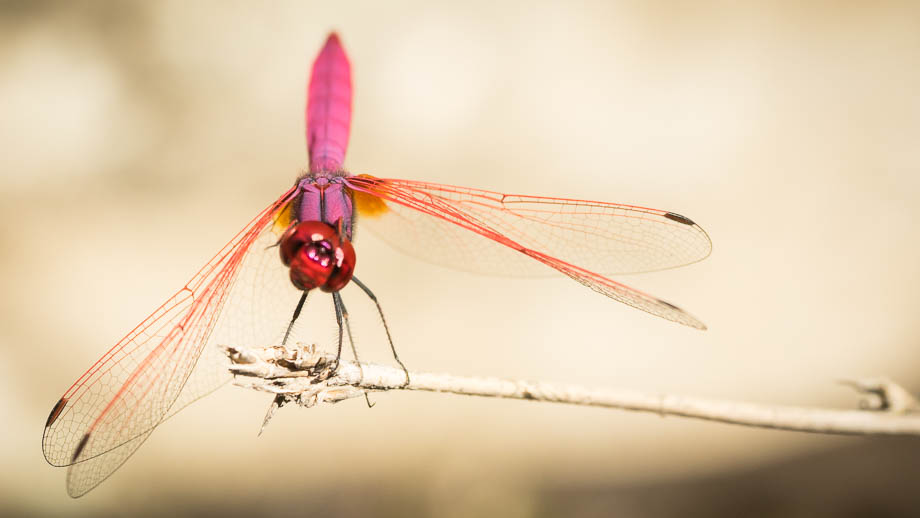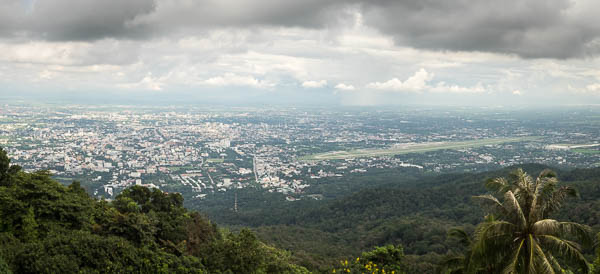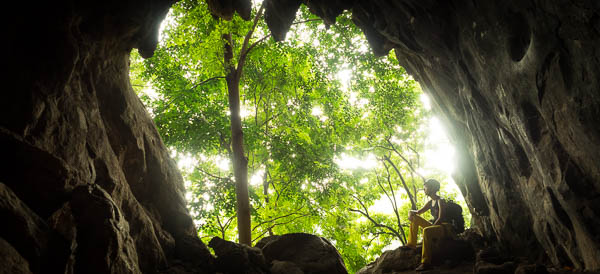September 17, 2016
Posted by
Ramon Fadli in
Budget,
Chiang Mai,
Dry Broadleaf Forests,
Forests,
IUCN Protected Category 2,
Mountains,
National Parks,
Thailand,
Tropical Savanna,
Waterfalls Doi Inthanon
Waterfalls
The driver then brought us to visit the pagodas (entrance fee was
THB40/pax). I personally was not too impressed with the pagodas and viewed them as ostentatious structures that marred the beautiful natural landscape of the mountain, so felt that the entrance fee was a waste of money. We made our way to the Hmong market right after and wandered around examining all the wares that had been lined up (all manner of snacks, trinkets, and fruits) to cater to all the tourists that came through the area. We made our way past a strange, anachronistic petrol filler in a shed, before taking a seat in one of the food stalls for lunch (Fried rice,
THB40).
We continued on to what we thought was our last stop, Wachirathan waterfall (น้ำตกวชิรธาร). The carpark was chock-full of tourists, so we quickly disembarked and walked up the steps to the waterfall to get away from all the crowds. The waterfall was massive, apparently with a cumulative height of 80-metres, and it had a torrential flow that sent spray into the air in all directions as the water plummeted over the granite escarpment. The tourists began to crowd around the platform soon after, leaving me very uneasy and eager to break away. After a few shots of the waterfall, we made our way up the trail to the higher tiers.
 Wachirathan waterfall
Wachirathan waterfall

The trail wound its way up the hill, switch-backing every now and then, and after sticking right past the junction to stay close to the waterfall, we arrived at the first viewpoint. Despite this viewpoint being at the top of the main tier of the waterfall, the view was rather disappointing. We watched a few damselflies
(Matrona nigripectus) flitting around for a while before continuing along to the next tier. The view there was much better and afforded us a good view of the much wider and broader river section. The end of the trail was reached shortly after where it joined a road, so with nothing else to do we began to make our way back down to the songthaew.
 A male Matrona nigripectus damselfly
A male Matrona nigripectus damselfly
On the way back down the mountain, the songthaew made an unexpected stop at the Mae Klang waterfall (น้ำตกแม่กลาง) that was located just after the first checkpoint (at kilometre 8). This is a large waterfall and is one of the easiest to get to, making it quite a popular destination for Thais. We were initially uncertain if we had sufficient time to explore the waterfall but the driver managed to reassure us that we would indeed be able to catch a songthaew back to Chiang Mai. We jumped out once again and made our way up the road and produced our park tickets for the park ranger to check. The road was fairly short and lead us up to the base of the main waterfall.
Dragonflies are riparian, so there were plenty of them skimming around the banks of the river. One of them, the male crimson marsh glider
(Trithemis aurora), with its vivid red/purple colour really stood out amongst the rest. This dragonfly seemed to like perching on twigs that were exposed to the sun, and would oftentimes be facing straight down to the ground with its abdomen raised in the air almost as if it were doing a handstand of sorts.
One of the easiest things to look out for when trying to differentiate dragonflies from damselflies are the eyes: dragonflies have much larger eyes that begin at the front of the head and wrap around to the sides. These eyes are also positioned quite close to each other. Damselflies on the other-hand have eyes that are slightly smaller, with a noticeable gap between them at the front of their head. Another big difference are the wings. Although both dragonflies and damselflies have two sets of wings, dragonflies have hind wings that are larger than their front wings, and hold them out perpendicular to their bodies when resting. Damselflies have sets of wings that are very similar in size, and fold them up and hold them vertically above the top of their backs. The way the wings are positioned at rest is also used when differentiating moths from butterflies: moths hold them out perpendicular to their bodies, and butterflies hold them vertically above the top of their backs.
 Crimson marsh glider (Trithemis aurora)
Crimson marsh glider (Trithemis aurora)
Not too long after, we discovered a set of hewn rocks just beyond the viewing platform and decided to follow them. The steps brought us to a trail that lead us up and past a large rock-face to our right that was covered with bee nests, before emerging out into an open area at the top. The view of the Mae Klang waterfall was very impressive from this viewpoint but unfortunately we were unable to stay for very long since we were chasing for time. So after a while, we turned back around and made our way back down to the waiting songthaew.
 Mae Klang waterfall
Mae Klang waterfall
**The cost for the songthaew back to Chiang Mai was
THB35/pax, with dinner costing me
THB60 (supplemented by meat on sticks
THB40). The final payment for the last four days of accommodation amounted to
THB500**

 The trail wound its way up the hill, switch-backing every now and then, and after sticking right past the junction to stay close to the waterfall, we arrived at the first viewpoint. Despite this viewpoint being at the top of the main tier of the waterfall, the view was rather disappointing. We watched a few damselflies (Matrona nigripectus) flitting around for a while before continuing along to the next tier. The view there was much better and afforded us a good view of the much wider and broader river section. The end of the trail was reached shortly after where it joined a road, so with nothing else to do we began to make our way back down to the songthaew.
The trail wound its way up the hill, switch-backing every now and then, and after sticking right past the junction to stay close to the waterfall, we arrived at the first viewpoint. Despite this viewpoint being at the top of the main tier of the waterfall, the view was rather disappointing. We watched a few damselflies (Matrona nigripectus) flitting around for a while before continuing along to the next tier. The view there was much better and afforded us a good view of the much wider and broader river section. The end of the trail was reached shortly after where it joined a road, so with nothing else to do we began to make our way back down to the songthaew.








